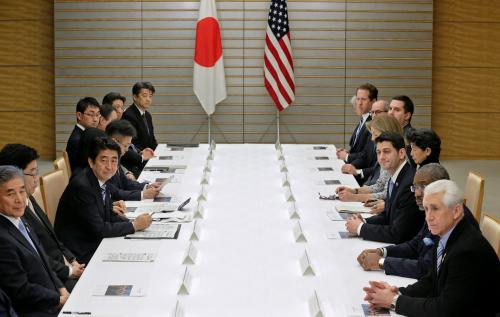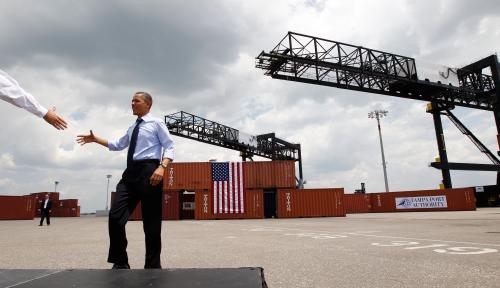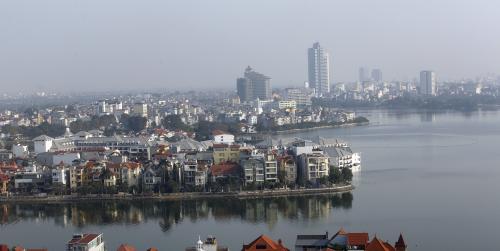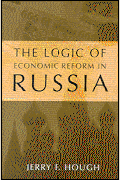In October the Trans-Pacific Partnership (TPP) agreement was concluded. Involving 12 countries including the United States, Japan, Canada, Mexico, Chile, Australia, Vietnam, Singapore, and New Zealand, the TPP parties represent approximately 40 percent of global GDP and 25 percent of world exports. The U.S. administration’s goal is for the TPP to be the cornerstone of a free trade agreement of the Asia-Pacific region. Already South Korea, Indonesia, the Philippines, Thailand, and Taiwan have expressed interest in joining. While open to participation by other countries, many developing countries such as India and those in Africa are unlikely to be able to accept the high standards the TPP sets in terms of market access commitments and rules.
In order for the TPP to come into effect requires ratification by the U.S. Congress. The administration is likely to make a focused effort to have this done in the first half of 2016, having consistently touted the TPP as a 21st century trade agreement. In many respects, the agreement achieves these goals in areas such as environmental protection and labor, new rules on state-owned enterprises, and the digital economy. In other areas, the TPP falls short of this goal, particularly when dealing with more traditional issues, such as reform of Canada dairy supply chain. That said, the TPP is an important agreement that will provide economic and strategic benefits to the U.S., and these benefits will expand over time.
Imports and exports
The TPP will further underpin the international rules-based trade and investment system for economic growth in the Asia Pacific region. The TPP will create new opportunities for U.S. exporters in areas where barriers remain high, such as in agriculture, services, and high-end manufacturing. The TPP includes new commitments on intellectual property and investment, and makes significant progress reducing tariffs in areas of key export interest for the U.S.
On the import side, the already-relatively low average U.S. tariff rate means that the impact of the TPP on U.S. industry from imports will be small. Moreover, the integration of U.S. businesses into global supply chains means that access to lower-cost imports will increase the competitiveness of U.S. businesses domestically and in overseas markets.
Environmental protection, the digital economy, and other 21st century issues
The TPP rules will also create a framework for development in the Asia-Pacific region on issues such as data flows and state-owned enterprises that furthers U.S. economic and broader strategic interests. In areas such as the environment and labor, the TPP demonstrates that international trade and investment can support greater levels of environmental and labor rights protection than would exist without the agreement.
Specifically, the TPP covers all the environmental issues under the seven multilateral environmental agreements (MEAs) referred to in the recently approved Trade Promotion Authority passed by Congress; and in many respects the TPP strengthens and expands the scope of environmental protection. For example, for trade in wildlife fauna and flora, the TPP affirms the CITES convention and includes additional commitments to address trade in illegal logs. Some MEAs, such as the Ramsar Convention (on wetlands) and CCAMLR convention (Antarctic marine resources), are not specifically mentioned in the TPP, but in these cases the TPP includes specific commitments on the core environmental issues addressed by these treaties and in many cases expands these commitments. The TPP also includes disciplines on subsidies that lead to overfishing—an outcome that has been pursued unsuccessfully at the World Trade Organization for the last 15 years. The TPP environment chapter is subject to the agreement’s state-to-state dispute settlement.
The TPP includes new rules that support the digital economy, such as a commitment to cross-border data flows and to not require data localization. This is important given the enormous opportunities that the Internet and the ability to move data globally is creating for business to engage in international trade. The digital economy is also enabling small- and medium-sized enterprises and developing countries to participate in the global economy in ways that were not previously possible.
The TPP includes new rules on state-owned enterprises (SOEs) that require them to compete on a level-playing field when engaged in commercial activities, including by not providing so-called non-commercial assistance such as low-cost loans, debt forgiveness, or preferential access to goods and services. Such rules on SOEs are important given the role of SOEs in economies such as Vietnam and Malaysia. Rules on SOEs (along with many of the other TPP discipline) also set an important baseline for reform should China become serious about joining the TPP.
What is in it for developing countries?
Finally, the TPP is important because of what it demonstrates globally in terms of the possibility of making progress on trade and investment liberalization and the capacity of the U.S. to lead such an effort. For one, the diversity of countries involved—lower-middle-income countries such as Vietnam, upper-middle-income countries such as Malaysia and Mexico, and high-income countries such as Japan, Australia, Canada, and Chile—sends an important message about the benefits to all countries of undertaking further trade and investment liberalization, committing to high standards and new regulations and rules on issues such as labor and the environment.
Take Vietnam, for instance. Its willingness to agree to the TPP represents a serious commitment by its government to economic and even some political reform. For the first time, Vietnam will allow for the independent formation of labor unions as a result of the TPP labor chapter. Vietnam’s willingness to liberalize its services sectors and to commit to new digital economy rules on data flows is supporting growth in its IT sector, as companies such as IBM build data centers and invest in research and development facilities. Indeed, the ability for Vietnam to agree to the TPP has led some in China to ask why China can’t also commit to similar reforms and join the agreement.
The TPP benefits all parties. In fact, the largest gains from the TPP will be in those countries laboring under high levels of protection, such as Japan and Vietnam—reflecting the fact that the gains from any trade agreement ultimately flow from the domestic liberalization that follows. But while the overall impact of the TPP on the U.S. economy may seem relatively small given the already open nature of the U.S. economy and the small amount of trade with TPP countries as a share of U.S. GDP, the agreement brings with it some valuable economic benefits for the U.S. from new market access opportunities. Perhaps most importantly, the TPP will underpin important reforms and positive growth trajectories across TPP parties that are also consistent with U.S. values and economic interests going forward. It is in this respect that the TPP is an important economic and strategic win for the U.S.









Commentary
The Trans-Pacific Partnership is a win for all parties
December 9, 2015